I came out to the garden the other day and noticed this batch of small red eggs on my pumpkin leaves. What the heck?!
Of course, I then realized they were the infamous squash bug eggs. Ugh. So let’s talk about how to get rid of these eggs, and squash bugs altogether so I don’t have to deal with this again.
What are Squash Bugs?
Squash bugs are brownish-black insects with flattened bodies and long antennae. They kind of look like a stink bug.
The adults have wings but rarely fly, which makes trying to catch them a little easier. They lay red eggs that become squash bug nymphs that have black or grayish-brown bodies and red legs.
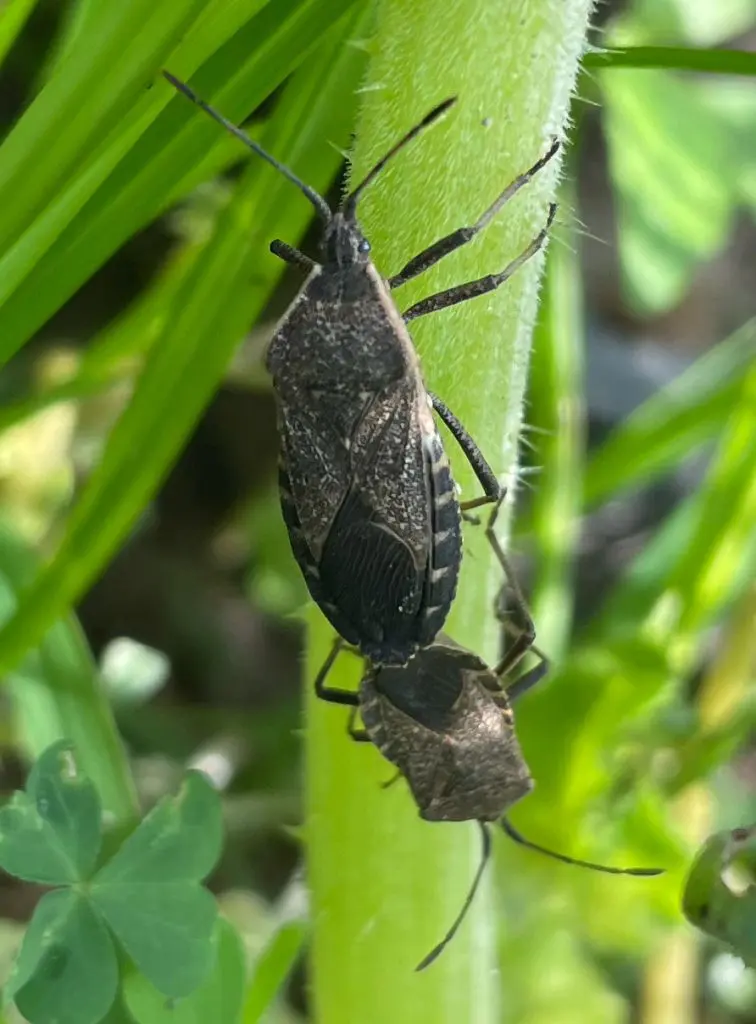
Nymphs also do not venture far from where they emerge in the spring. They feed on the undersides of leaves and lay their eggs on the stems or leaf petioles.
Common name: Squash bug, Anasa tristis
Scientific name: Anasa tristis
Other names: squash bug, vegetable stinkbug
Plants affected:
- Squash plants (including summer squash, yellow squash, winter squash, and zucchini)
- Cucumbers
- Zucchini
- Pumpkins
- Melons (including Watermelons)
- Other cucurbits
They are major pests of cucurbits (i.e. melons, pumpkins, gourds, squash, etc.) and can do some major damage if you don’t control squash bugs early.
TL;DR – Helpful Products to Get Rid of Squash Bugs
- Neem Oil
- Diatomaceous Earth
- Soapy Water
What Do Squash Bugs Look Like?
The life cycle of squash bugs is similar to other garden pests. Eggs, nymphs, and adults are often the types you’ll see on your plants.
But let’s be real: squash bug eggs look like seeds.
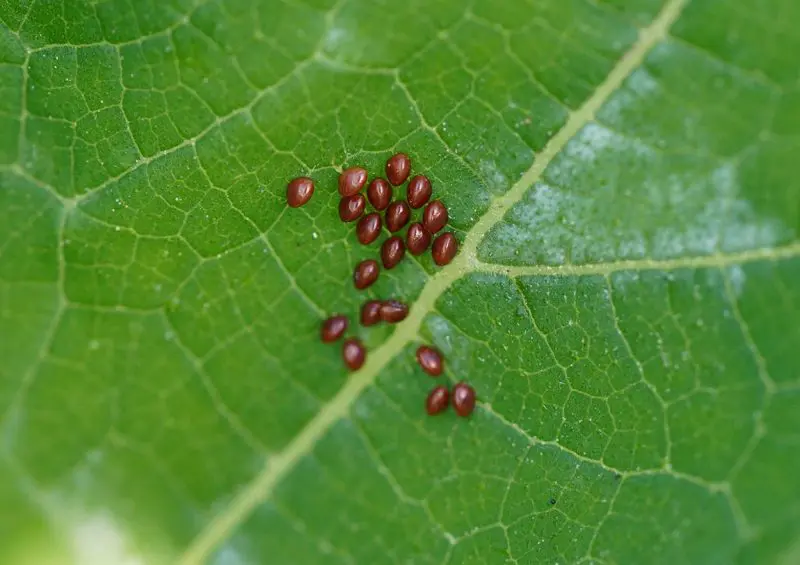
Squash Bug Eggs
Squash bugs lay red eggs that are around 1/8 inch long and laid in clusters of 10-50 eggs on the plant. The eggs can be on the underside of leaves, but also on top of leaves. They’re usually placed on the leaves along the stemlines.
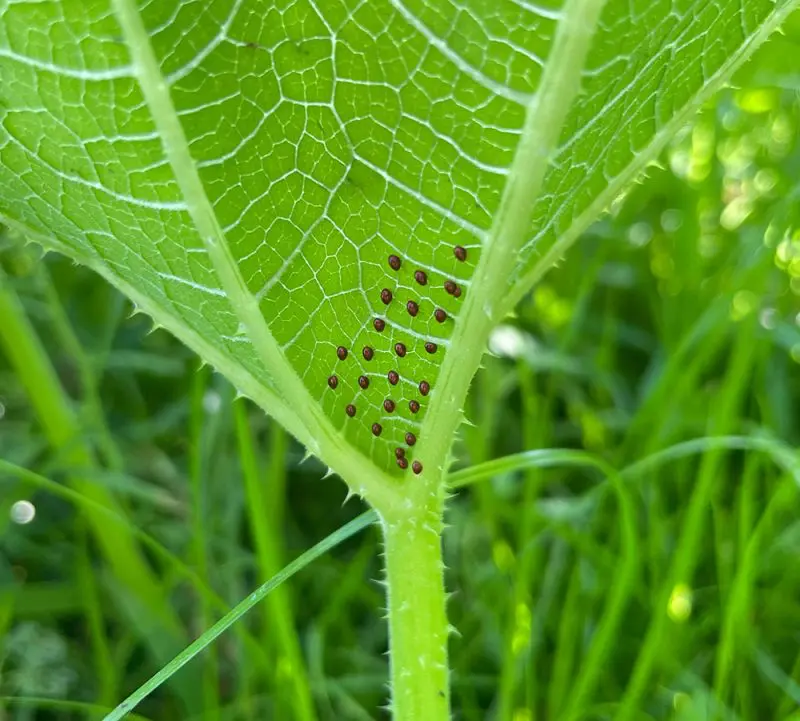
The eggs start out as a red/brown color, then change to lighter and lighter until they are yellow or white which means they are about to hatch.
You might see these red eggs on your leaf stems and leaves (especially pumpkin, zucchini, and gourds).
Squash Bug Nymphs
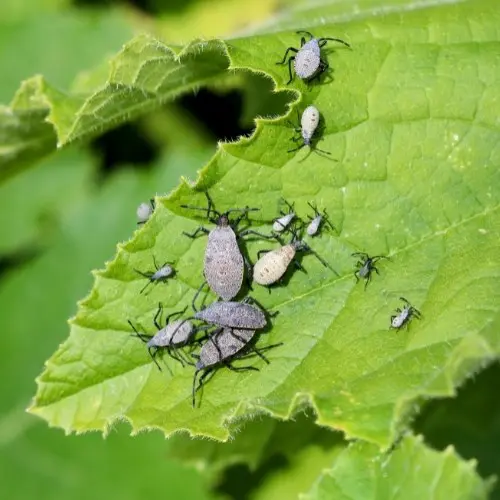
Squash bugs take about a week to develop in the eggs, and once they do, they emerge with a vengeance. These green bugs with red/brown legs appear and will grow into adult-sized squash bugs in about 4-6 weeks. As nymphs mature, they develop a dark gray or black coloration.
Squash bug nymphs are gregarious (i.e. they don’t like to be alone) and typically hang out close to where they hatch, preferring to feed along leaf midribs.
Nymphs begin feeding in spring at ground level or on vines near the soil surface. They usually do not cause serious injury to young plants but can severely damage older or stressed cucurbits.
The nymphs feed by inserting their needle-like mouthparts into the plant and withdrawing the nutritious juices. The feeding wounds they make on the leaves of squash and other cucurbits are often confused with the feeding wounds caused by squash vine borers.
Adult Squash Bugs
An adult squash bug is about 1/2 inch long and dark brown to black in color with long legs and antennae (longer than leaf hopper antennae).
Mature squash bugs look kind of like stink bugs but they don’t have that “coat of armor” look to them. They are similar in coloring but are more elongated and round.
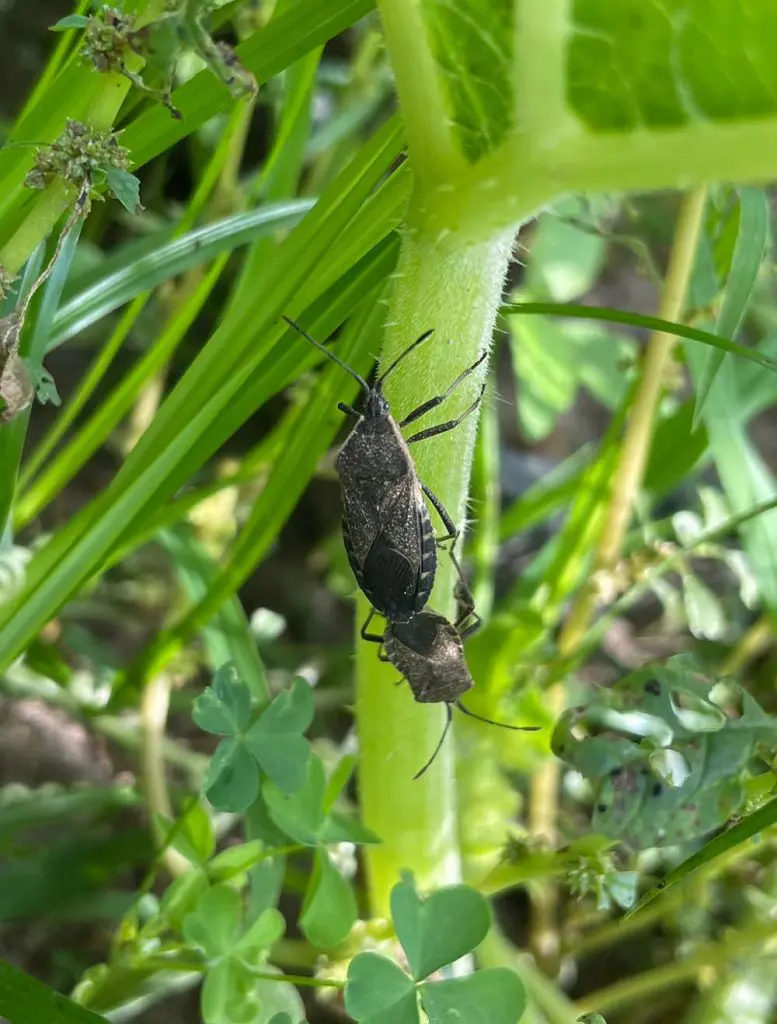
Squash bugs can live for 1-3 years, and the most fun part is that they can overwinter in garden debris like dead leaves or dead plants, survive the winter, and return the following spring and lay more eggs. They move up into the plants when temperatures begin to rise in spring and may be found on the upper portions of stems, leaves, and fruit.
So we get to see them again next year! I cannot WAIT.
Squash Bug Damage
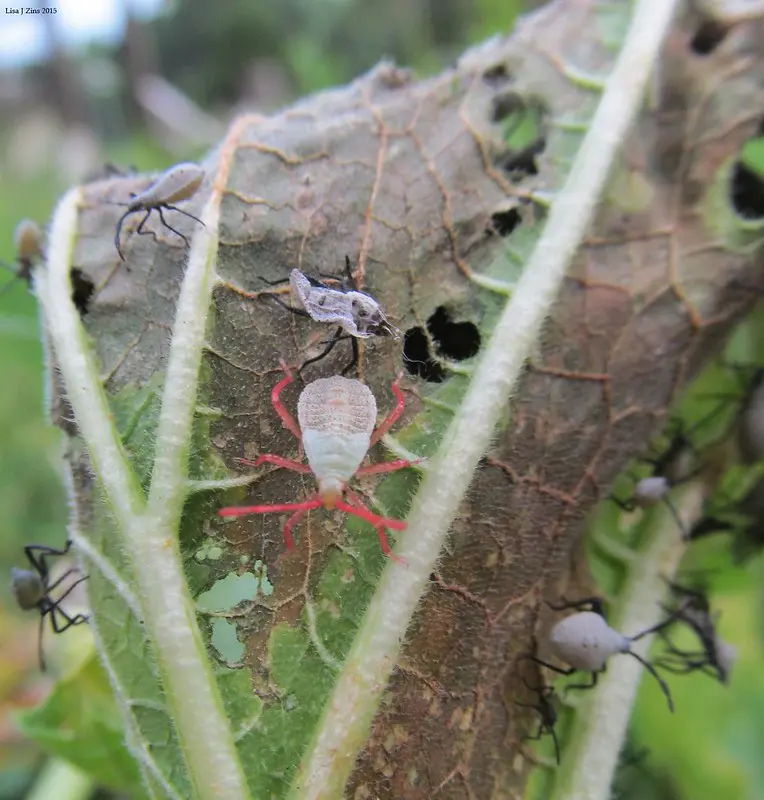
Squash bugs feed on the juice from plants, which can turn into brown leaves and holes. Severe feeding damage can interfere with plant growth and fruit development.
The feeding activity of adult squash bugs also produces leaf lesions called “stippling” which are essentially small dots of damage on the leaves.
Leaves and stems may wither and die, particularly when plants are under stress. Large numbers of these insects can contribute to the transmission of plant viruses like bacterial wilt, which can further reduce yield and fruit quality.
How to Get Rid of Squash Bug Eggs
If you find one squash bug or a cluster of eggs, you want to take care of this right away. It is important to control these little suckers as soon as they are detected because a single female can lay 50 eggs or more during her lifetime. And those eggs hatch, they can lay eggs too.

And like compound interest, your squash bug farm has just grown exponentially.
So let’s avoid that and get rid of them before they hatch.
The Soapy Water Method
This one is simple but effective.
Get a jar, bowl, or some kind of container. Using a spoon, knife, or some kind of tool, you can scrape the eggs into a jar of soapy water.
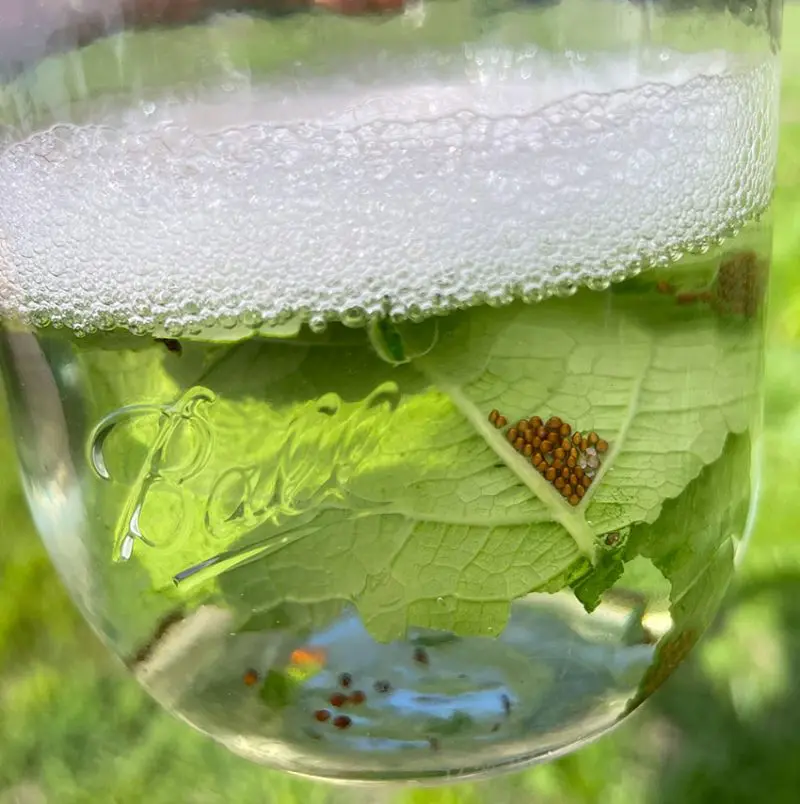
After they are in the soapy water, I usually leave them there for at least a few minutes to ensure they are dead, and then you can dump the water out.
It’s not enough to just scrape the eggs off the plant. The eggs will fall to the ground and can still hatch. So do your best to get them into the soapy water so they won’t be able to hatch.
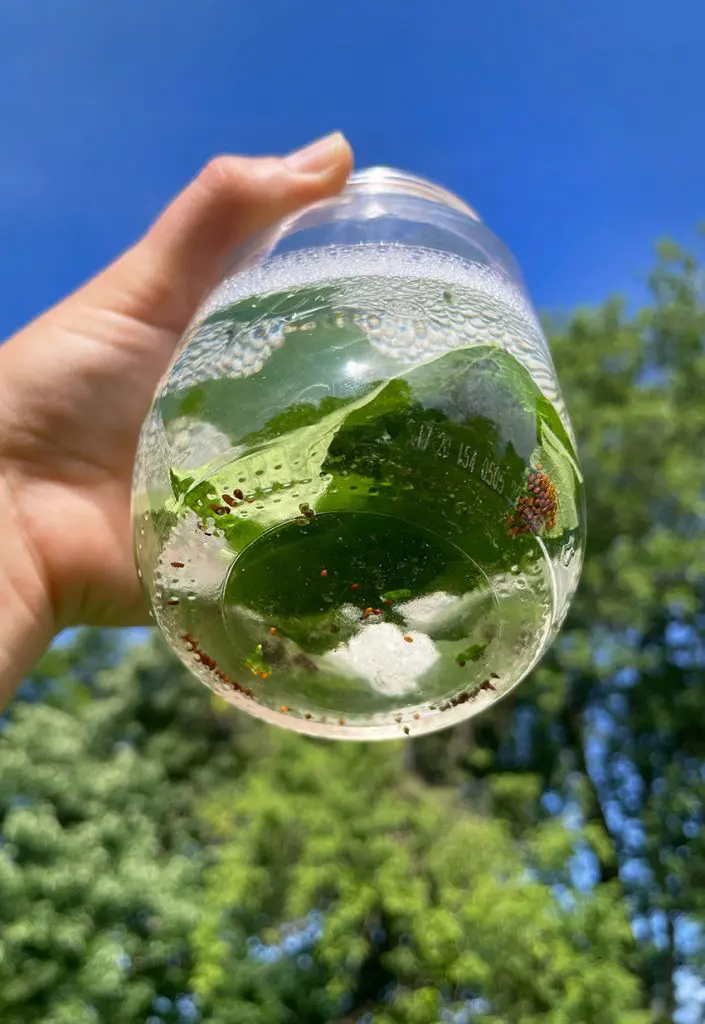
You can spray the plants with soap, but beware that you could be introducing other issues. Dish soap contains chemicals that removes grease and wax, which can also remove the protective layer plants have on their leaves. This can introduce pathogens and other issues.
If you do end up spraying the leaves, give them a good rinse of regular water within an hour to help remove any excess soap.
Packing Tape
Packing tape is a great option for removing squash bug eggs before they hatch. It’s strong enough to pick up the eggs, but isn’t as strong as other tapes that will stick to the leaves and damage them.
Simply brush the tape along the egg cluster to pick up the eggs. Once you’re done, fold another sticky side on top to keep them in place so they cannot get out if they do indeed hatch.
You can then put the tape into a plastic bag and throw it away. You can also put the tape into a soapy water jar just to be sure.
Neem Oil
Neem oil is a great way to get rid of eggs and adult squash bugs. It’s also a great option to help control other bugs that can wreak havoc on your vegetable gardens.
With eggs, you’ll want to dab them with a Q-tip or spray the cluster. If you find live adult bugs or nymphs, spray them well with the oil as this kills squashs bugs.
After that, spray neem oil on your plant leaves, stems, and more once every week or two to ensure you replace any that was lost through rain.
100% cold-pressed neem oil that can be used as a foliar spray for healthy garden plants. Free of water and other additives.
Diatomaceous Earth
Diatomaceous earth has SO many uses in the garden. It can help with ants and other soft-bodied insects.
Sprinkle diatomaceous earth around the base of your plants to help get rid of squash bugs, and help prevent vine borers from moving in.
You don’t want to sprinkle the entire plant, as diatomaceous earth can harm pollinators. If you don’t have pollinators, you won’t get much squash as the flowers will go unpollinated.
Companion Planting
Companion planting is when you plant crops and vegetables that benefit one another nearby. For example, catnip is one plant said to help repel squash bugs. Planting some catnip nearby would be considered companion planting.
Other companion plants that help repel squash bugs are:
- Catnip
- Radishes
- Nasturtiums
- Marigolds
- Mint
- Bee Balm
- Tansy
- Yarrow
- Cosmos
Planting these nearby can help with controlling squash bugs in your garden.
What To Do if You Have a Squash Bug Infestation
Dish soap contains potassium salt which kills soft-bodied insects like squash bugs, by breaking down their outer shell, causing them to dry up and eventually die.
Because squash bugs don’t fly, insecticides can be applied directly to them or to their hiding places without harming people, pets, wildlife, pollinators, and other desirable insects.
Squash bug populations can be managed with insecticide products containing permethrin, bifenthrin, cypermethrin, malathion, and lambda-cyhalothrin.
B.t., or Bacillus thuringiensis, is another garden spray you can use to help prevent and kill squash bugs.
B.T. is a great spray for getting rid of hornworms and other unwanted caterpillars and worms that can destroy your garden plants and vegetables.
These can be applied in the early morning or late evening when squash bugs are least likely to contact crops, beneficial insects, and honey bees. Always read product labels for the proper instructions to dilute these. Just spraying these on hoping for the best could harm your plants, so be smart about this.
How to Prevent Squash Bugs
Using neem oil is a great way to prevent squash bugs from making their home in your garden in the first place.
Apply it once a week to keep out squash bugs, aphids, and more.





